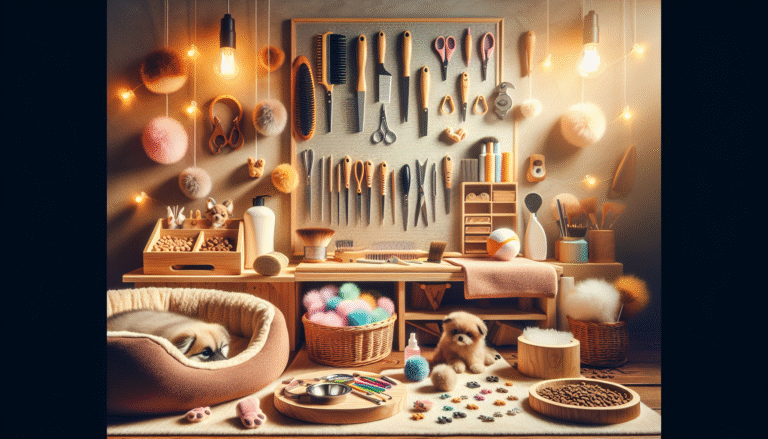Is your new puppy struggling to find their place at home?
Using a dog crate can be a game changer for both you and your furry friend. Not only does it create a safe environment for your puppy, but it also aids significantly in training and developing good habits. Understanding the purpose of dog crates and how to use them effectively can set the stage for a harmonious living situation for you and your pup.
The Purpose of Dog Crates in Puppy Training
Essential for Crate Training Puppies
A crate can serve as a secure haven for your puppy. When you introduce a crate properly, it becomes a space where your puppy feels safe and comfortable. This setup can aid tremendously in housebreaking, as dogs have a natural instinct not to soil their sleeping area. By guiding your puppy to associate their crate with safety and comfort, you promote good habits right from the start.
Aiding in Housebreaking
Many pet owners find that using a crate dramatically simplifies housebreaking. Since dogs typically avoid soiling their sleeping space, it encourages them to hold it until they are let outside. This is a crucial step in training, as it helps instill good bathroom habits. When used properly, the crate becomes a vital tool that reinforces your puppy’s understanding of where and when to eliminate.
Providing a Secure Sleeping Space
Every puppy needs their own space. Crates mimic the den-like environment that dogs are instinctively drawn to. A crate can serve as a secure sleeping area where your puppy can retreat when they feel tired or overwhelmed. This not only comforts them but also helps create a consistent routine that fosters a sense of security.
Key Features to Look for in a Dog Crate
Sturdy Construction
When selecting a crate, durability should top your list of priorities. A sturdy crate can withstand the playful antics of energetic puppies. Look for materials that can resist chewing and scratching. The last thing you want is for your puppy to escape when you’re not watching!
Well-Ventilated Design
Optimal airflow is important for your puppy’s comfort. A well-ventilated crate ensures that your puppy can breathe comfortably while resting or waiting for you. Look for crates that offer ventilation panels or mesh openings to maintain airflow.
Secure Door Mechanism
Safety is paramount, and a secure door is essential for preventing unwanted exits. Choose a crate that features a reliable locking mechanism which will keep your puppy safe inside. This way, you can rest easy knowing your puppy won’t wander off unsupervised.
Not Used for Punishment
Crating should never be associated with punishment. If your puppy views their crate as a negative space, it will hinder all the benefits it can offer. Always introduce the crate positively, making it a welcoming place for your pup to enjoy.
Testing Overview of Dog Crates
Finding the right crate can be overwhelming, given the numerous options available. To ease your decision-making, a comprehensive testing overview examined over 20 dog crates in New York, aiming to identify the best ones for puppies. This analysis focused on various features, usability, and safety to provide you with a well-rounded recommendation.
Top Picks for Dog Crates
When it comes to choosing the top crates for your puppy, here are some exceptional options that stood out during testing.
Best Overall: MidWest Homes for Pets iCrate
The MidWest Homes for Pets iCrate offers an excellent blend of functionality and comfort. Here are some key features:
- Two-Point Access: Allows easy entry and exit from either side, providing flexibility.
- Divider Panel: You can adjust the size as your puppy grows, making it a worthwhile investment.
- Leak-Proof Base: Perfect for accidents, ensuring easy cleanup.
- Easy Assembly and Transport: Quick setup and portability make it convenient for any situation.
Best for Home: Diggs Revol Dog Crate
If style and functionality are important to you, the Diggs Revol Dog Crate is a fantastic choice.
- Aesthetically Pleasing: It has a sleek design, blending seamlessly into your home décor.
- Sturdy Construction: The frame is robust, offering lasting durability.
- Multiple Access Points: With various doors, your puppy can enter and exit easily.
- Wheeled Base for Transport: Ideal for moving around the house or when traveling.
Best for Car Rides: Ruff Land Kennel
For dog owners who love to travel, the Ruff Land Kennel makes car rides far safer and more comfortable.
- Safer One-Piece Construction: There are no seams that can fail during travel.
- Multiple Door Configurations: Adaptable to various vehicle sizes without sacrificing security.
- Ventilated Design: Ensures your puppy stays cool and comfortable en route.
- “Rattle-less” Feature: Reduces noise during travel, keeping your puppy calm.
Best for Travel: Lesure Soft Collapsible Dog Crate
For those moments when you’re on the go, the Lesure Soft Collapsible Dog Crate stands out.
- Lightweight and Portable: Easy to carry, making it perfect for travel situations.
- Good Ventilation: Multiple access points for airflow keep your puppy comfortable.
- Collapsible Design: Stores easily when not in use, saving space at home.
Recommendations for Choosing the Right Crate
The right crate can significantly enhance your puppy’s comfort, security, and training process. Here are several recommendations to keep in mind when making your selection:
Consider Size
Size matters! Ensuring the crate is appropriate for your puppy’s current size while allowing for growth is essential. An ideal crate should have enough space for your puppy to stand up, turn around, and lie down comfortably without feeling cramped.
Evaluate Material
Crates come in various materials, including plastic, metal, and fabric. Each has its benefits, so consider the specific needs of your puppy. For example, heavier breeds may require sturdier metal options, while smaller breeds may do well in lightweight fabric crates.
Assess Features
Not all crates offer the same features. Look for models that cater to your specific requirements. Whether it’s a divider panel for size adjustment, waterproof bases, or portability, identifying what features will help simplify life for you and your puppy is crucial.
Think About Usage
Lastly, consider your intended usage. Are you primarily using the crate for home training, travel, or car rides? Your answer will guide your choice of materials and type of crate.
Conclusion
Understanding the purpose of dog crates in puppy training is vital for creating a safe, secure, and nurturing environment for your new furry companion. Not only do they assist in housebreaking and provide a comforting place for sleep, but they also cultivate a disciplined routine as your puppy learns the cues of their new life with you.
Selecting the right crate is equally important, as it can directly impact the training process. By considering factors like size, material, and essential features tailored to your needs, you can ensure a harmonious coexistence and contribute positively to your puppy’s development.
As you embark on this journey with your puppy, remember that the crate can be a wonderful ally in your training endeavors, paving the way for a well-behaved and happy dog.



